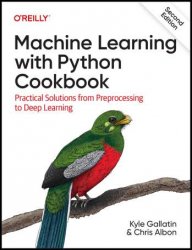Machine Learning with Python Cookbook, 2nd Edition (Final Release)
- Добавил: literator
- Дата: 26-09-2023, 20:39
- Комментариев: 0
 Название: Machine Learning with Python Cookbook: Practical Solutions from Preprocessing to Deep Learning, 2nd Edition (Final Release)
Название: Machine Learning with Python Cookbook: Practical Solutions from Preprocessing to Deep Learning, 2nd Edition (Final Release)Автор: Kyle Gallatin, Chris Albon
Издательство: O’Reilly Media, Inc.
Год: 2023
Страниц: 416
Язык: английский
Формат: pdf (true), epub (true), mobi
Размер: 10.2 MB, 10.2 MB
This practical guide provides more than 200 self-contained recipes to help you solve Machine Learning challenges you may encounter in your work. If you're comfortable with Python and its libraries, including Pandas and Scikit-learn, you'll be able to address specific problems all the way from loading data to training models and leveraging neural networks.
Each recipe in this updated edition includes code that you can copy, paste, and run with a toy dataset to ensure it works. From there, you can adapt these recipes according to your use case or application. Recipes include a discussion that explains the solution and provides meaningful context. Go beyond theory and concepts by learning the nuts and bolts you need to construct working machine learning applications.
NumPy is a foundational tool of the Python Machine Learning stack. NumPy allows for efficient operations on the data structures often used in machine learning: vectors, matrices, and tensors. While NumPy isn’t the focus of this book, it will show up frequently in the following chapters. The Chapter 1 covers the most common NumPy operations we’re likely to run into while working on Machine Learning workflows.
Just as NumPy is a foundational tool for data manipulation in the machine learning stack, PyTorch is a foundational tool for working with tensors in the deep learning stack. Before moving on to deep learning itself, we should familiarize ourselves with PyTorch tensors and create many operations analogous to those performed with NumPy in Chapter 1. Although PyTorch is just one of multiple deep learning libraries, it is significantly popular both within academia and industry. PyTorch tensors are very similar to NumPy arrays. However, they also allow us to perform tensor operations on GPUs (hardware specialized for deep learning). In this chapter, we’ll familiarize ourselves with the basics of PyTorch tensors and many common low-level operations.
You'll find recipes for:
Vectors, matrices, and arrays
Working with data from CSV, JSON, SQL, databases, cloud storage, and other sources
Handling numerical and categorical data, text, images, and dates and times
Dimensionality reduction using feature extraction or feature selection
Model evaluation and selection
Linear and logical regression, trees and forests, and k-nearest neighbors
Support vector machines (SVM), naive Bayes, clustering, and tree-based models
Saving and loading trained models from multiple frameworks
Скачать Machine Learning with Python Cookbook, 2nd Edition (Final Release)
True PDF:
ePub, mobi:
Внимание
Уважаемый посетитель, Вы зашли на сайт как незарегистрированный пользователь.
Мы рекомендуем Вам зарегистрироваться либо войти на сайт под своим именем.
Уважаемый посетитель, Вы зашли на сайт как незарегистрированный пользователь.
Мы рекомендуем Вам зарегистрироваться либо войти на сайт под своим именем.
Информация
Посетители, находящиеся в группе Гости, не могут оставлять комментарии к данной публикации.
Посетители, находящиеся в группе Гости, не могут оставлять комментарии к данной публикации.
